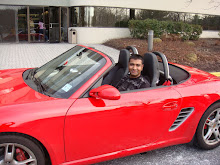A cursor expression returns a nested cursor. Each row in the result set can contain values as usual, plus cursors produced by subqueries involving the other values in the row. A single query can return a large set of related values retrieved from multiple tables. You can process the result set with nested loops that fetch first from the rows of the result set, then from any nested cursors within those rows.
PL/SQL supports queries with cursor expressions as part of cursor declarations, REF CURSOR declarations and ref cursor variables. You can also use cursor expressions in dynamic SQL queries. Here is the syntax:
CURSOR(subquery)
A nested cursor is implicitly opened when the containing row is fetched from the parent cursor. The nested cursor is closed only when:
The nested cursor is explicitly closed by the user
The parent cursor is reexecuted
The parent cursor is closed
The parent cursor is canceled
An error arises during a fetch on one of its parent cursors. The nested cursor is closed as part of the clean-up.
Restrictions on Cursor Expressions
The following are restrictions on cursor expressions:
You cannot use a cursor expression with an implicit cursor.
Cursor expressions can appear only:
In a SELECT statement that is not nested in any other query expression, except when it is a subquery of the cursor expression itself.
As arguments to table functions, in the FROM clause of a SELECT statement.
Cursor expressions can appear only in the outermost SELECT list of the query specification.
Cursor expressions cannot appear in view declarations.
You cannot perform BIND and EXECUTE operations on cursor expressions.
Example of Cursor Expressions
In Example 6-35, we find a specified location ID, and a cursor from which we can fetch all the departments in that location. As we fetch each department's name, we also get another cursor that lets us fetch their associated employee details from another table.
Example 6-35 Using a Cursor Expression
DECLARE
TYPE emp_cur_typ IS REF CURSOR;
emp_cur emp_cur_typ;
dept_name departments.department_name%TYPE;
emp_name employees.last_name%TYPE;
CURSOR c1 IS SELECT
department_name,
-- second item in the result set is another result set,
-- which is represented as a ref cursor and labelled "employees".
CURSOR
( SELECT e.last_name FROM employees e
WHERE e.department_id = d.department_id) employees
FROM departments d WHERE department_name like 'A%';
BEGIN
OPEN c1;
LOOP
FETCH c1 INTO dept_name, emp_cur;
EXIT WHEN c1%NOTFOUND;
DBMS_OUTPUT.PUT_LINE('Department: ' || dept_name);
-- for each row in the result set, the result set from a subquery is processed
-- the set could be passed to a procedure for processing rather than the loop
LOOP
FETCH emp_cur INTO emp_name;
EXIT WHEN emp_cur%NOTFOUND;
DBMS_OUTPUT.PUT_LINE('-- Employee: ' || emp_name);
END LOOP;
END LOOP;
CLOSE c1;
END;
/
Constructing REF CURSORs with Cursor Subqueries
You can use cursor subqueries, also know as cursor expressions, to pass sets of rows as parameters to functions. For example, this statement passes a parameter to the StockPivot function consisting of a REF CURSOR that represents the rows returned by the cursor subquery:
SELECT * FROM TABLE(StockPivot(
CURSOR(SELECT * FROM StockTable)));
Cursor subqueries are often used with table functions, which are explained in "Setting Up Transformations with Pipelined Functions".
Tuesday, September 30, 2008
Using Cursor Expressions [Cursor in Select statement]
Tuesday, September 9, 2008
Art Of Living Birthday Song
Sagar Mein Ek Leher(Birthday Song)
Sagar Mein Ek Lehar Uthi Aapke Naam ki.
Aapko Mubarak Khushiyan har sansaar ki,
Aapko hai Anant mein jaakar mil jaana,
Aap hain sundar Bund is chetna ki. ……. Sagar
This birthday song was drafted and composed in fifteen minutes. One day when Guruji was sitting at Sumeru and celebrating the fortieth B’day of a devotee. When the gathering started singing the well worn birthday song, Guruji admonished them to stop singing the same old weather-beaten song and compose some new tune---and thus this song was born---with the blessings of the master himself. The original song is in Hindi and the English translation is as below.
Today is the day waves remember
The Ocean where it was born
And today is the day we all remember
That, this world is our very own.
Happy Birthday to you (2)
We belong to you Happy Birthday to Dear Guruji
We all are your very own Yes,
we all are your very own
The Art Of Living Website (All about Meditation, Yoga, Breathing Techniques, Stress Relief)
Sagar Mein Ek Lehar Uthi Aapke Naam ki.
Aapko Mubarak Khushiyan har sansaar ki,
Aapko hai Anant mein jaakar mil jaana,
Aap hain sundar Bund is chetna ki. ……. Sagar
This birthday song was drafted and composed in fifteen minutes. One day when Guruji was sitting at Sumeru and celebrating the fortieth B’day of a devotee. When the gathering started singing the well worn birthday song, Guruji admonished them to stop singing the same old weather-beaten song and compose some new tune---and thus this song was born---with the blessings of the master himself. The original song is in Hindi and the English translation is as below.
Today is the day waves remember
The Ocean where it was born
And today is the day we all remember
That, this world is our very own.
Happy Birthday to you (2)
We belong to you Happy Birthday to Dear Guruji
We all are your very own Yes,
we all are your very own
The Art Of Living Website (All about Meditation, Yoga, Breathing Techniques, Stress Relief)
Subscribe to:
Comments (Atom)
